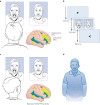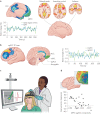Novel mechanism-based treatments for pediatric anxiety and depressive disorders
- PMID: 37608220
- PMCID: PMC10700626
- DOI: 10.1038/s41386-023-01709-x
Novel mechanism-based treatments for pediatric anxiety and depressive disorders
Abstract
Pediatric anxiety and depressive disorders are common, can be highly impairing, and can persist despite the best available treatments. Here, we review research into novel treatments for childhood anxiety and depressive disorders designed to target underlying cognitive, emotional, and neural circuit mechanisms. We highlight three novel treatments lying along a continuum relating to clinical impact of the disorder and the intensity of clinical management required. We review cognitive training, which involves the lowest risk and may be applicable for problems with mild to moderate impact; psychotherapy, which includes a higher level of clinical involvement and may be sufficient for problems with moderate impact; and brain stimulation, which has the highest potential risks and is therefore most appropriate for problems with high impact. For each treatment, we review the specific underlying cognitive, emotional, and brain circuit mechanisms that are being targeted, whether treatments modify those underlying mechanisms, and efficacy in reducing symptoms. We conclude by highlighting future directions, including the importance of work that leverages developmental windows of high brain plasticity to time interventions to the specific epochs in childhood that have the largest and most enduring life-long impact.
© 2023. The Author(s), under exclusive licence to American College of Neuropsychopharmacology.
Conflict of interest statement
The authors declare no competing interests.
Figures



Similar articles
-
Effectiveness of a transdiagnostic internet-based protocol for the treatment of emotional disorders versus treatment as usual in specialized care: study protocol for a randomized controlled trial.Trials. 2015 Oct 31;16:488. doi: 10.1186/s13063-015-1024-3. Trials. 2015. PMID: 26519046 Free PMC article. Clinical Trial.
-
Cognitive-behavioral psychotherapy for anxiety and depressive disorders in children and adolescents: an evidence-based medicine review.J Am Acad Child Adolesc Psychiatry. 2004 Aug;43(8):930-59. doi: 10.1097/01.chi.0000127589.57468.bf. J Am Acad Child Adolesc Psychiatry. 2004. PMID: 15266189 Review.
-
Psychotherapeutic approaches to the treatment of anxiety and depressive disorders.J Clin Psychiatry. 1997;58 Suppl 13:30-2. J Clin Psychiatry. 1997. PMID: 9402917 Review.
-
[Efficacy of psychiatric and psychotherapeutic interventions in children and adolescents with psychiatric disorders--a systematic evaluation of meta-analyses and reviews. Part I: Anxiety disorders and depressive disorders].Z Kinder Jugendpsychiatr Psychother. 2008 Sep;36(5):309-20. doi: 10.1024/1422-4917.36.5.309. Z Kinder Jugendpsychiatr Psychother. 2008. PMID: 18791981 Review. German.
-
Towards an evidence-based unified psychodynamic protocol for emotional disorders.J Affect Disord. 2018 May;232:400-416. doi: 10.1016/j.jad.2017.11.036. Epub 2017 Nov 11. J Affect Disord. 2018. PMID: 29522960 Review.
Cited by
-
Social Determinants of Health, the developing brain, and risk and resilience for psychopathology.Neuropsychopharmacology. 2025 Jul 16:10.1038/s41386-025-02169-1. doi: 10.1038/s41386-025-02169-1. Online ahead of print. Neuropsychopharmacology. 2025. PMID: 40670623 Review.
-
Current and Future Approaches to Pediatric Anxiety Disorder Treatment.Am J Psychiatry. 2024 Mar 1;181(3):189-200. doi: 10.1176/appi.ajp.20231037. Am J Psychiatry. 2024. PMID: 38425255 Free PMC article. Review.
References
-
- Merikangas KR, He J-P, Burstein M, Swanson SA, Avenevoli S, Cui L, et al. Lifetime prevalence of mental disorders in U.S. adolescents: results from the National Comorbidity Survey Replication-Adolescent Supplement (NCS-A) J Am Acad Child Adolesc Psychiatry. 2010;49:980–9. doi: 10.1016/j.jaac.2010.05.017. - DOI - PMC - PubMed
Publication types
MeSH terms
Grants and funding
LinkOut - more resources
Full Text Sources
Medical

